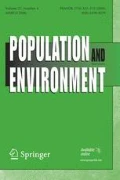Abstract
The environmental consequences of increasing human population size are dynamic and nonlinear, not passive and linear. The role of feedbacks, thresholds, and synergies in the interaction of population size and the environment are reviewed here, with examples drawn from climate change, acid deposition, land use, soil degradation, and other global and regional environmental issues. The widely-assumed notion that environmental degradation grows in proportion to population size, assuming fixed per capita consumption and fixed modes of production, is shown to be overly optimistic. In particular, feedbacks, thresholds, and synergies generally amplify risk, causing degradation to grow disproportionally faster than growth in population size.






Similar content being viewed by others
References
Daily, G. (Ed.). (1997). Nature’s services. Washington, DC: Island Press.
Ehrlich, P., & Holdren, J. (1971). The impact of population growth. Science, 171, 1212–1217.
Harte, J. (1988). Consider a spherical cow: A course in environmental problem solving. Mill Valley, CA: University Science Books.
Harte, J. (1993). The green fuse: An ecological Odyssey. Berkeley, CA: University of California Press.
Harte, J. (1996). Feedbacks, thresholds, and synergies in global change: Population as dynamic factor. Biodiversity and Conservation, 5, 1069–1083.
Harte, J., Holdren, C., Schneider, R., & Shirley, C. (1991). Toxics A to Z: A guide to everyday pollution hazards. Berkeley: University of California Press.
Harte, J., Torn, M., & Jensen, D. (1992). The nature and consequences of indirect linkages between climate change and biological diversity. In R. Peters & T. Lovejoy (Eds.), Global warming and biological diversity (pp. 325–343). New Haven: Yale University Press.
IPCC (2001). Climate change 2001: The scientific basis. Contribution of working group I to the third assessment report of the intergovernmental panel on climate change. Cambridge, UK: Cambridge University Press.
Kinzig, A., & Harte, J. (2000). Implications of endemics-area relationships for estimates of species extinctions. Ecology, 81(12), 3305–3311.
Lashof, D., DeAngelo, B., Saleska, S., & Harte, J. (1997). Terrestrial ecosystem feedbacks to global climate change. Annual Review of Energy and the Environment, 22, 75–118.
L’Vovich, M., & White, G. (1990). Uses and transformations of terrestrial water systems. In B. Turner (Ed.), The Earth as transformed by human action (pp. 235–252). Cambridge, UK: Cambridge University Press.
Murray, J. D. (1989). Mathematical biology. Berlin: Springer-Verlag.
Myers, N. (1983). A wealth of wild species. Boulder: Westview.
NRC/NAS (1995). Science and the Endangered Species Act. Committee on Scientific Issues in the Endangered Species Act, Commission on Life Sciences, National Research Council. Washington DC: National Academy Press.
Pacala, S., & Socolow, R. (2004). Stabilization wedges: Solving the climate problem for the next 50 years with current technologies. Scientific American, 305, 968–972.
Postel, S. (1993). Water and agriculture. In P. Gleick (Ed.), Water in crisis: A guide to the world’s fresh water resources (pp. 56–66). Oxford: Oxford University Press.
Postel, S., Daily, G., & Ehrlich, P. (1996). Human appropriation of renewable fresh water. Science, 271, 785–788.
Rozanov, B., Targulian, V., & Orlov, D. (1990). Soils. In B. Turner (Ed.), The Earth as transformed by human action (pp. 203–214). Cambridge, UK: Cambridge University Press.
Schlesinger, W. (1991). Biogeochemistry: An analysis of global change. San Diego: Academic Press.
Shiklomanov, I. A. (1993). World fresh water resources. In P. Gleick (Ed.), Water in crisis: A guide to the world’s fresh water resources (pp. 13–24). Oxford: Oxford University Press.
Torn, M., & Harte, J. (2006). Missing feedbacks, asymmetric uncertainties, and the underestimation of future warming. Geophysical Reserch Letters, 33, L10703. doi: 10.1029/2005GL025540M.
Westman, W. (1977). How much are natures services worth? Science, 197, 960–964.
Author information
Authors and Affiliations
Corresponding author
Additional information
Based on a presentation to the Bixby Symposium on Population and Conservation, UC Berkeley, May 2006.
Rights and permissions
About this article
Cite this article
Harte, J. Human population as a dynamic factor in environmental degradation. Popul Environ 28, 223–236 (2007). https://doi.org/10.1007/s11111-007-0048-3
Published:
Issue Date:
DOI: https://doi.org/10.1007/s11111-007-0048-3




